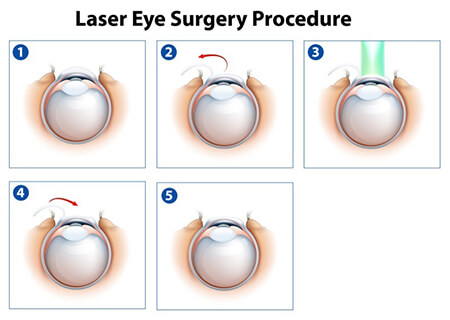 Prior to the procedure, an extremely detailed examination of your eyes is performed. This examination includes visual acuity measurements, intraocular pressure assessments, refraction, and a detailed evaluation of the anatomic structures including lacrimal apparatus, conjunctiva, cornea, iris, lens, and retina. Advanced analyses of corneal topography and corneal thickness are also performed along with a Wave Scan.
Prior to the procedure, an extremely detailed examination of your eyes is performed. This examination includes visual acuity measurements, intraocular pressure assessments, refraction, and a detailed evaluation of the anatomic structures including lacrimal apparatus, conjunctiva, cornea, iris, lens, and retina. Advanced analyses of corneal topography and corneal thickness are also performed along with a Wave Scan.
This detailed information is used by Dr. Barrett to formulate a surgical plan and develop a computerized treatment program designed to maximize your vision. This surgical plan will be discussed with you for your understanding and approval prior to Laser Vision Correction. Pre-procedure sedation will be offered to those who request it.
Before you enter the laser suite, your LASIK technician will perform a sterilizing preoperative skin prep around your eyes and place a few anesthetic drops in your eyes to prevent discomfort.
Once the laser has been properly calibrated and tested, Dr. Barrett will place a sterile drape around your eye. A specially designed eyelid holder will be placed between your eyelids to keep them open throughout the procedure. In LASIK, Dr. Barrett then uses a microkeratome (an automated microsurgical instrument) to create a corneal flap that has a thickness of approximately 160 microns. In Epi-LASIK, a bladeless microkeratome removes the epithelial surface cells of the cornea. A cool laser beam of light from the Excimer laser is then used to precisely and gently reshape your cornea. Once the laser energy has been applied to the cornea, the LASIK flap is carefully put back into place and the eyelid holder is removed. In Epi-LASIK a soothing therapeutic contact lens is placed on the surface of the eye.
During your Laser Vision Correction procedure, you can rest assured that small movements of your eye will not complicate your results as our VISX S4 Custom Vue laser is equipped with automatic pupil centering and eye-tracking functions.
After your procedure is completed, you will relax in the recovery examination room and receive postoperative instructions. Dr. Barrett will perform a postoperative examination to ensure that everything is in order before you leave. You will also be given your post-operative eye drop medications in addition to sunglasses to reduce the discomfort that sunlight may cause. Protective goggles designed to be worn while sleeping will be given to you for use during the first postoperative week.
Upon leaving the laser center, many patients will feel the need to rest for a few hours. Keeping your eyes closed for several hours after the procedure is always recommended. Later that evening, most patients feel very well and are extremely pleased with their results already. Many patients go back to work the next day, while others wait a few days.
You will need to go for a post-operative check-up following your procedure to ensure that your eyes are healing as expected. There are a few restrictions for a week or so following your procedure, but as long as you follow the instructions, you should be free to resume all of your normal activities within ten days.

